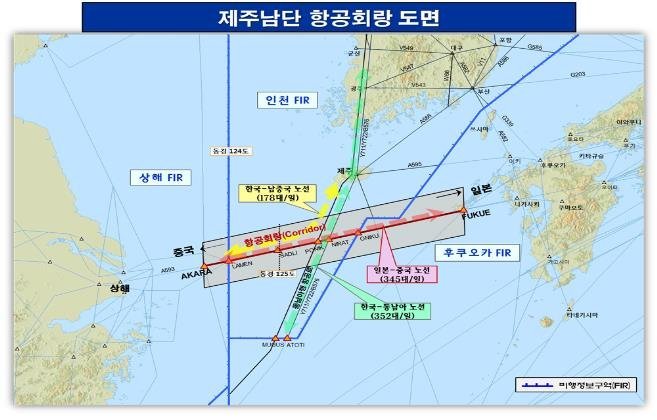South Korea, China and Japan are in final talks to accept a United Nations aviation agency's proposal for an agreement critical for the safety of flights near Korea's southern resort island of Jeju, the transport ministry said Thursday.
South Korean and Japanese air traffic controllers have been directing north-south flights and east-west flights, respectively, in the "Akara corridor," which is part of South Korean airspace.
Japan has shepherded flights between Shanghai and Japan on behalf of China, according to the Ministry of Land, Infrastructure and Transport.
 |
(Yonhap) |
The International Civil Aviation Organization has recently suggested South Korea take over Japan's role and guide flights in and out of Shanghai on behalf of China, a ministry official said over the phone.
"The three parties are in discussions over the proposal and are expected to come up with a decision soon or later," he said.
The proposal was accepted by the three states. The trilateral agreement is expected to be formalized in January or February and would take effect in April, ICAO Council President Olumuyiwa Benard Aliu said in an interview with Reuters.
The ministry declined to comment on the report.
The three nations also discussed the need to increase the number of routes between China and Japan and to generate an airway between Korea and China, the ministry said.
The three nations made the current air traffic control arrangements in 1983 when airplanes made only dozens of flights a day in the Akara corridor.
As the number of flights in the Asia-Pacific region has risen sharply on higher travel demand and next summer's Tokyo Olympics draw near, the ICAO has urged them to streamline traffic control in the corridor.
Seoul had called on Japan to actively join multilateral talks to enhance the safety of flights in the air corridor that stretches over three offshore points -- Akara in China, South Korea's flight information region near Jeju Island and Japan's Fukue Island.
In the corridor, which is 519 kilometers long and 93 km wide, airlines use eight altitudes to avoid collisions.
South Korean and Japanese air traffic controllers operate on different radio frequencies, raising the risk of potential collision due to difficulties in communications with pilots, as well as turbulence and bad weather.
The potential deal comes amid a trade row between South Korea and Japan over the latter's export curbs targeting its neighbor.
Since July this year, the two Asian neighbors have been involved in an unprecedented trade tussle as Japan abruptly imposed tough regulations on the export of key industrial materials to South Korea, citing Seoul's lax control system of strategic goods that can be diverted for military uses.
But the Seoul government regards Japan's export regulations as a retaliation against a Seoul court's rulings on compensation for wartime forced labor.
Seoul announced its decision to end a military information-sharing pact with Japan in August, but just hours before the termination of the deal, South Korea's National Security Council decided to "conditionally" suspend the termination of the pact. (Yonhap)








